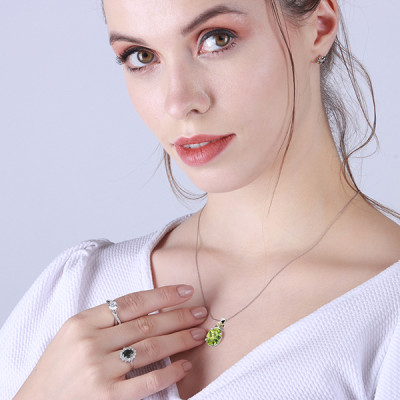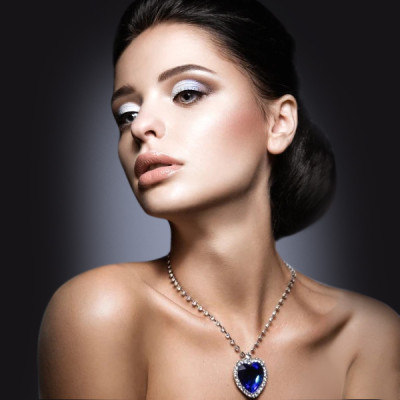OPAL GUIDE
(OCTOBER BIRTHSTONE)
October Birthstone - Opal
As October's traditional birthstone, opal is believed to be a precious and powerful symbol of love, with the ability to promote romance, passion and hope. Both extremely valuable black and more common white opals have been seen as romantic and celebratory gifts worldwide for thousands of years, from Cleopatra to Queen Victoria. Alongside being a birthstone, opal is also a customary 14th wedding anniversary gift, further reflecting this stone's romantic history and precious nature.
Learn more about this beautiful, dramatic and colourful gemstone by reading below:
What does an opal symbolise?
Historically, the October birthstone has been given as a romantic gift, from elegant necklaces to unique engagement rings that symbolise lifelong commitment. Since Roman and Greek times, opals have been a powerful reflection of hope, passion, romance, purity and truth. Ancient Greeks even believed that opals could grant visions of the future, all the more reason for this stone to be a top choice for proposals and lifelong romantic partners.
Are opal rings in style?
The elegant style and unique nature of opal rings mean they are always in style. From highly traditional settings to modern, minimalist rings, the versatility of opal allows them to look stylish in just about any environment. The colourful nature of the opal has directly influenced many fashion trends, from iridescent clothing items to sophisticated jewellery and hair accessories.
Which finger should I wear an opal ring on?
The finger you wear your opal ring on depends on the ring's purpose. As a traditional engagement gift, many women and men choose to wear an opal ring on their wedding finger – the fourth finger on the left hand. This placement is closest to the heart, which lends itself well to this gem's romantic and passionate history.
What are the benefits of wearing opal?
Over the decades, there have been many beliefs surrounding opals. As a gem once known as a way to view the future, it's no surprise that one of the most significant benefits of opal covers the health and care of the eyes and vision. Other suggested benefits include aiding in blood purification, boosting memory, improving immunity and handling symptoms related to PMS and similar health concerns.
How do I care for my opal ring?
Opals are relatively soft stones and must be well cared for with monthly cleaning. A solid opal ring can be cleaned gently with a soft tool, such as a cloth or toothbrush, and swished in a solution of warm water and mild dish soap. You must clean opal separately from harder gems such as rubies or diamonds, as these can scratch your ring. Opal rings are porous, so you want to avoid leaving them in water for any longer than a couple of minutes to prevent damage.
Faq
Viewing an opal under a strong white light is a good starting point to figure out whether your gemstone is real, as in a genuine opal this will reveal a wide range of colours on the surface. Air bubbles and an entirely smooth surface are key signs of an imitation opal made of glass. If a stone also feels far too affordable for its appearance and quality, it may be a fake.
The cost of an opal depends on a wide array of different factors. The type of opal, such as white or black, the brilliance of the stone, the pattern, the play of colour and any faults are considered when deciding upon this ultimate value of an opal. The ideal way to know the value of a specific piece is to ask a jeweller with experience in grading gemstones.
The vibrant quality of opals and their unique appeal make them an excellent investment if you'd like to purchase valuable jewellery. Black opals, in particular, are often worth more than diamonds, providing greater value per piece of jewellery you invest in. The softer nature of opal and their ability to be scratched or damaged further improves their worth and scarcity, making these opals more valuable over time.
Whether you prefer opals or diamonds is entirely down to personal preference. Both gemstones represent love and passion in their own way.
The Ancient Romans considered the opal to be one of the luckiest gemstones. Even in medieval times, opals were seen as a sign of luck and positivity thanks to their rainbow of unique colours.
Opals are porous stones, which means they can be damaged by water over time. Washing your hands won't cause lasting damage, but submerging opal jewellery can lead to dulling, damage and similar problems over time.
Opal is a softer gemstone than diamond or other common ring gems. This softness means that, throughout the day, wear and tear can cause a tiny amount of damage to your opal ring that worsens over time. Opals are best kept for special occasions, though the tarnishing and ageing of an opal ring can signify the longevity of a relationship if you choose to wear it daily.
Much like daily wear and tear, it's possible to scratch or damage opal jewellery in your sleep. Storing it safely in a jewellery box overnight is the ideal way to keep your valuable pieces safe.
Particular opals can turn yellow over time due to the materials used to process them. Ethiopian opals, in particular, often use stabilising resins, which become yellow over time. Chemical contact can also yellow opals, such as using an ultrasonic cleaner.
Browse our range of birthstone jewellery online today to discover the perfect gift for your loved one.
Want to learn more about birthstone meanings? Check out our birthstone guides by month:
Browse All 12 Birthstone Guides
-

Garnet
January Birthstone -

Amethyst
February Birthstone -

Aquamarine
March Birthstone -

Diamond
April Birthstone -

Emerald
May Birthstone -

Pearl
June Birthstone -

Ruby
July Birthstone -

Peridot
August Birthstone -

Sapphire
September Birthstone -

Opal
October Birthstone -

Topaz
November Birthstone -

Tanzanite
December Birthstone

Article written by Nilesh
 Trustpilot
Trustpilot



